Effects of Soil Water Regulation on the Cotton Yield, Fiber Quality and Soil Salt Accumulation under Mulched Drip Irrigation in Southern Xinjiang, China
Abstract
:1. Introduction
2. Materials and Methods
2.1. Experimental Site
2.2. Experimental Design and Arrangement
2.2.1. Experimental Design
2.2.2. Experimental Arrangement
2.3. Measurements and Methods
2.3.1. Soil Water Content and Salinity
2.3.2. Irrigation Amount and ET
2.3.3. Cotton Yield
2.3.4. WUE, IWUE and PFPN
2.3.5. Fiber Quality
2.3.6. Soil Salt
Soil Salt Accumulation
Soil Salination Rate
2.3.7. Economic Benefit
2.3.8. Observation of Groundwater Depth and Meteorological Data
2.3.9. Entropy Weight TOPSIS Method
2.4. Data Analysis
3. Results
3.1. Water Consumption Characteristics of Cotton
3.2. Cotton Yield, Water and Nitrogen Use Efficiency
3.3. Fiber Quality
3.4. Soil Salt Accumulation
3.5. Optimization of Irrigation System
4. Discussion
4.1. Water Consumption Characteristics of Cotton
4.2. Cotton Yield, Water and Nitrogen Use Efficiency
4.3. Fiber Quality
4.4. Soil Salt Accumulation
5. Conclusions
Author Contributions
Funding
Institutional Review Board Statement
Informed Consent Statement
Data Availability Statement
Acknowledgments
Conflicts of Interest
References
- Pan, W.; Yang, D.G.; Yang, L.; Xiao, Y.Q.; Wang, G.G.; Tang, H. Spatio-temporal dynamics and optimal development scale of cotton industry in Xinjiang. Chin. J. Eco-Agric. 2011, 19, 415–420, (In Chinese with English abstract). [Google Scholar] [CrossRef]
- Li, M.; Du, Y.; Zhang, F.C.; Fan, J.L.; Ning, Y.; Cheng, H.L.; Xiao, C. Modification of CSM-CROPGRO-Cotton model for simulating cotton growth and yield under various deficit irrigation strategies. Comput. Electron. Agric. 2020, 179, 105843. [Google Scholar] [CrossRef]
- Xiao, C.; Li, M.; Fan, J.L.; Zhang, F.C.; Li, Y.; Cheng, H.L.; Li, Y.P.; Hou, X.H.; Chen, J.Q. Salt leaching with brackish water during growing season improves cotton growth and productivity, water use efficiency and soil sustainability in southern Xinjiang. Water 2021, 13, 2602. [Google Scholar] [CrossRef]
- Hou, X.H.; Xiang, Y.Z.; Fan, J.L.; Zhang, F.C.; Hu, W.H.; Yan, F.L.; Guo, J.J.; Xiao, C.; Li, Y.P.; Cheng, H.L.; et al. Evaluation of cotton N nutrition status based on critical N dilution curve, N uptake and residual under different drip fertigation regimes in Southern Xinjiang of China. Agric. Water Manag. 2021, 256, 107134. [Google Scholar] [CrossRef]
- Mane, R.B.; Tumbare, A.D.; Surve, U.S. Drip fertigation and crop management in Bt cotton (Gossypium hirsutum). Indian J. Agron. 2019, 63, 350–356. [Google Scholar]
- Che, Z.; Wang, J.; Li, J.S. Effects of water quality, irrigation amount and nitrogen applied on soil salinity and cotton production under mulched drip irrigation in arid Northwest China. Agric. Water Manag. 2021, 247, 106738. [Google Scholar] [CrossRef]
- Li, N.N.; Ma, H.; Wang, X.Y.; Li, J.H.; Han, H.Y.; Luo, H.H. Effects of drip irrigation quota on plant shape, yield and fiber quality of cotton. Agric. Res. Arid Areas 2019, 37, 16–21, (In Chinese with English abstract). [Google Scholar]
- Cui, Y.S.; Wang, F.; Sun, J.S.; Han, Q.S.; Wang, J.L.; Li, N. Effects of irrigation regimes on the variation of soil water and salt and yield of mechanically harvested cotton in Southern Xinjiang, China. Chin. J. Appl. Ecol. 2018, 29, 3634–3642, (In Chinese with English abstract). [Google Scholar]
- Doorenbos, J.; Kassam, A.H. Yield response to water. Irrig. Drain. Pap. 1979, 33, 257. [Google Scholar]
- Fares, A.; Alva, A.K. Evaluation of capacitance probes for optimal irrigation of citrus through soil moisture monitoring in an entisol profile. Irrig. Sci. 2000, 19, 57–64. [Google Scholar] [CrossRef]
- Gheysarl, M.; Sadeghi, S.H.; Loescher, H.W.; Amiri, S.; Mohammad, J.Z.; Majidi, M.M.; Asgarinia, P.; Payero, J.O. Comparison of deficit irrigation management strategies on root, plant growth and biomass productivity of silage maize. Agric. Water Manag. 2017, 182, 126–138. [Google Scholar] [CrossRef] [Green Version]
- Campbell, G.S.; Campbell, M.D. Irrigation scheduling using soil moisture measurements: Theory and practice. Adv. Irrig. 1982, 1, 25–42. [Google Scholar]
- Hanson, B.R.; Orloff, S.; Peters, D. Monitoring soil moisture helps refine irrigation management. Calif. Agric. 2000, 54, 38–42. [Google Scholar] [CrossRef] [Green Version]
- Zhao, Q.S.; Li, P.P.; Wang, J.Z.; Gao, B. Effects of irrigation threshold on growth and physiological characteristics of cucumber plug seedlings. Trans. CSAE 2011, 27, 31–35, (In Chinese with English abstract). [Google Scholar]
- Wang, H.Y.; Li, G.Y. Effect of Drip Irrigation Model and Irrigation Start Pointon Water Consumption and Yield of Sweet Melon. Trans. CSAE 2010, 41, 47–51, (In Chinese with English abstract). [Google Scholar]
- Wu, X.B.; Bai, M.j.; Li, Y.N.; Du, T.S.; Zhang, S.H.; Shi, Y.; Liu, Y.N. The Effect of Fertigation on Cabbage (Brassica oleracea L. var. capitata) Grown in a Greenhouse. Water 2020, 12, 1076. [Google Scholar] [CrossRef]
- Chen, K.L.; Zhao, J.H.; Fu, Q.P.; Ma, Y.J.; Wang, Z.R. The effects of different water and nitrogen treatments on the growth, yield and water consumption characteristics of winter wheat. Agric. Res. Arid Areas 2018, 36, 125–132, (In Chinese with English abstract). [Google Scholar]
- Ma, S.C.; Zhang, W.Q.; Duan, A.W.; Wang, T.C. Effects of controlling soil moisture regime based on root-sourced signal characteristics on yield formation and water use efficiency of winter wheat. Agric. Water Manag. 2019, 221, 486–492. [Google Scholar] [CrossRef]
- Greaves, G.E.; Wang, Y.M. Effect of regulated deficit irrigation scheduling on water use of corn in southern Taiwan tropical environment. Agric. Water Manag. 2017, 188, 115–125. [Google Scholar] [CrossRef]
- Pei, D.; Zhang, X.Y.; Kang, R. Effects of water deficit on cotton growth, physiology and yield. Eco-Agric. Res. 2000, 8, 54–57, (In Chinese with English abstract). [Google Scholar]
- Shen, X.J.; Zhang, J.Y.; Sun, J.S.; Li, M.S.; Wang, J.L.; Liu, H. Effect of drip irrigation pattern and irrigation lower limit on yield and quality of cotton. J. Drain. Irrig. Mach. Eng. 2014, 32, 711–718, (In Chinese with English abstract). [Google Scholar]
- Pan, J.J.; Fu, Q.P.; Abudoukayimu, A.; Ma, Y.J. Effects of irrigation limits at bud stage and flowering stage on yield of drip irrigation cotton. Agric. Res. Arid Areas 2019, 37, 27–32, (In Chinese with English abstract). [Google Scholar]
- Yuan, Y.X.; Zhang, F.C.; Zhang, Y.; Suo, Y.S. Effects of irrigation threshold and fertilization on growth‚ yield and physiological properties of fertigated tomato in greenhouse. Agric. Res. Arid Areas 2013, 31, 76–83, (In Chinese with English abstract). [Google Scholar]
- Li, B.; Bao, Z.R.; Yao, M.Z.; Li, C.X.; Sun, X.L. Effects of irrigation lower limit and straw returning amount on yield, quality and water use efficiency of greenhouse tomato. Chin. J. Appl. Ecol. 2020, 31, 493–500, (In Chinese with English abstract). [Google Scholar]
- Zhang, Y.X.; Zhang, F.C.; Zou, H.Y.; Chen, D.F. Effects of soil water regulation in growing period on spring wheat growth and water use in Hexi areas under drip irrigation. Agric. Res. Arid Areas 2017, 35, 171–177, (In Chinese with English abstract). [Google Scholar]
- Wang, J.W.; Niu, W.Q.; Zhang, M.Z.; Li, Y. Response of muskmelon growth to film covering, drip pipes density and irrigation lower limits in greenhouse. Trans. CSAE 2016, 32, 117–125, (In Chinese with English abstract). [Google Scholar] [CrossRef]
- Yilmaz, E.; Gürbüz, T.; Dadelen, N.; Wzorek, M. Impacts of different irrigation water levels on the yield, water use efficiency, and fiber quality properties of cotton (gossypium hirsutum l.) irrigated by drip systems. Euro-Mediterr. J. Environ. Integr. 2021, 6, 1–7. [Google Scholar] [CrossRef]
- Yang, H.L.; Zhang, D.W.; Zhang, D.Y.; Bozorov, T.A.; Abdullaev, A.A.; Wood, A.J.; Wang, J.C.; Li, X.S.; Zhao, J.Y. Overexpression of ALDH21 from Syntrichia caninervis Moss in Upland Cotton Enhances Fiber Quality, Boll Component Traits, and Physiological Parameters during Deficit Irrigation. Crop Sci. 2019, 59, 553–564. [Google Scholar] [CrossRef] [Green Version]
- Lascano, R.J.; Baumhardt, R.L.; Goebel, T.S.; Baker, J.T.; Dennis, C.G. Irrigation termination thermal time and amount on cotton lint yield and fiber quality. Open J. Soil Sci. 2017, 7, 216–234. [Google Scholar] [CrossRef] [Green Version]
- Zhang, D.Y.; Li, J.N.; Niu, X.; Deng, C.Y.; Song, X.H.; Li, W.X.; Cheng, Z.M.; Xu, Q.A.; Zhang, B.H.; Guo, W.Z. GhANN1 modulates the salinity tolerance by regulating ABA biosynthesis, ion homeostasis and phenylpropanoid pathway in cotton. Environ. Exp. Bot. 2021, 185, 104427. [Google Scholar] [CrossRef]
- Li, B.Q.; Tian, Q.; Wang, X.W.; Han, B.; Liu, L.; Kong, X.H.; Si, A.J.; Wang, J.; Lin, Z.X.; Zhang, X.L.; et al. Phenotypic plasticity and genetic variation of cotton yield and its related traits under water-limited conditions. Crop J. 2020, 8, 966–976. [Google Scholar] [CrossRef]
- Wang, P.P.; He, S.P.; Sun, G.F.; Pan, Z.E.; Sun, J.L.; Geng, X.L.; Peng, Z.; Gong, W.F.; Wang, L.R.; Pang, B.Y.; et al. Favorable pleiotropic loci for fiber yield and quality in upland cotton (Gossypium hirsutum). Sci. Rep. 2021, 11, 1–12. [Google Scholar] [CrossRef] [PubMed]
- Liu, H.; Gao, Y.; Sun, J.S.; Wu, X.L.; Jha, S.K.; Zhang, H.; Gong, X.W.; Li, Y. Responses of yield, water use efficiency and quality of short-season cotton to irrigation management: Interactive effects of irrigation methods and deficit irrigation. Irrig. Sci. 2017, 35, 125–139. [Google Scholar] [CrossRef]
- Wang, R.; Ji, S.; Zhang, P.; Meng, Y.L.; Wang, Y.H.; Chen, B.L.; Zhou, Z.G. Drought Effects on Cotton Yield and Fiber Quality on Different Fruiting Branches. Crop Sci. 2016, 56, 1265–1276. [Google Scholar] [CrossRef]
- Bilalis, D.; Patsiali, S.; Karkanis, A.; Konstantas, A.; Makris, M.; Efthimiadou, A. Effects of cultural system (organic and conventional) on growth and fiber quality of two cotton (Gossypium hirsutum L.) varieties. Renew. Agric. Food Syst. 2010, 25, 228–235. [Google Scholar] [CrossRef]
- Hu, W.; Snider, J.L.; Wang, H.M.; Zhou, Z.G.; Chastain, D.R.; Whitaker, J.; Perry, C.D.; Bourland, F.M. Water-induced variation in yield and quality can be explained by altered yield component contributions in field-grown cotton. Field Crop. Res. 2018, 224, 139–147. [Google Scholar] [CrossRef]
- Zhou, H.F.; Ma, J.L. Studies on water-salt dynamics and balance of cotton crops land in tarim irrigation region. J. Irrig. Drain. 2005, 24, 10–14, (In Chinese with English abstract). [Google Scholar]
- Liu, X.Y.; Tian, C.Y.; Ma, Y.J.; Liu, H.P. Water consumption characteristics and scheduling of drip irrigation under plastic film for cotton in south Xinjiang. Agric. Res. Arid Areas. 2016, 24, 108–113, (In Chinese with English abstract). [Google Scholar]
- Wang, J.; Xiao, J.; Wang, J. Selection of optimal irrigation parameters under mulch drip irrigation of cotton in arid inland river irrigation area of Xinjiang. Water Resour. Res. 2008, 29, 26–28, (In Chinese with English abstract). [Google Scholar]
- Bai, M.; Lu, T.B.; Xu, Q.; Wang, D.W.; Wang, Z.L.; Niu, J.R. Effect of Water Regulation on Water and Salt Movement in Machine Cotton. Southwest China J. Agric. Sci. 2020, 33, 842–847, (In Chinese with English abstract). [Google Scholar]
- Luo, Y.; Mao, Y.; Peng, S.; Zheng, Q.; Wang, W.; Jiao, X.; Feng, Y. Modified Aver’yanov’s phreatic evaporation equations under crop growing. Trans. CSAE 2013, 29, 102–109, (In Chinese with English abstract). [Google Scholar]
- Tan, S.; Wang, Q.J.; Xu, D.; Zhang, J.H.; Shan, Y.Y. Evaluating effects of four controlling methods in bare strips on soil temperature, water, and salt accumulation under film-mulched drip irrigation. Field Crops Res. 2017, 214, 350–358. [Google Scholar] [CrossRef]
- Wang, G.S.; Shi, H.B.; Li, X.Y.; Guo, J.W.; Wang, W.G.; Wu, D. Estimation of salt transport and relationship with groundwater depth in different land types in Hetao Irrigation Area. Trans. CSAE 2020, 51, 255–269, (In Chinese with English abstract). [Google Scholar]
- Zou, H.Y.; Fan, J.L.; Zhang, F.C.; Xiang, Y.Z.; Wu, L.F.; Yan, S.C. Optimization of drip irrigation and fertilization regimes for high grain yield, crop water productivity and economic benefits of spring maize in Northwest China. Agric. Water Manag. 2020, 230, 105986. [Google Scholar] [CrossRef]
- He, P.R.; Zhang, F.C.; Fang, J.L.; Hou, X.H.; Liu, X.; Zhang, Y.C.; Xue, Z.Q. Effects of soil moisture regulation on growth quality and water use of cotton under drip irrigation in southern Xinjiang. Agric. Res. Arid Areas 2020, 38, 39–46, (In Chinese with English abstract). [Google Scholar]
- Yan, Y.Y. Cotton water requirements and water saving benefit under mulched drip irrigation in tarim irrigated area. Res. Soil Water Conserv. 2016, 23, 123–127, (In Chinese with English abstract). [Google Scholar] [CrossRef]
- Wang, L.; Guo, R.S.; Wumaierjiang, K.; Tian, L.; Tian, L.W.; Lin, T.; Zheng, Z.P.; Xu, H.J.; Kong, F.Y.; Cui, J.P. Effects of subsoiling depth on water use efficiency and yield of cotton field under drip irrigation in south Xinjiang, China. Trans. CSAE 2020, 36, 144–152, (In Chinese with English abstract). [Google Scholar] [CrossRef]
- Cai, H.J.; Shao, G.C.; Zhang, Z.H. Water demand and irrigation scheduling of drip irrigation for cotton under plastic mulch. J. Hydraul. Eng. 2002, 33, 119–123, (In Chinese with English abstract). [Google Scholar]
- Schaefer, C.R.; Ritchie, G.L.; Bordovsky, J.P.; Lewis, K.; Kelly, B. Irrigation timing and rate affect cotton boll distribution and fiber quality. Agron. J. 2018, 110, 922–931. [Google Scholar] [CrossRef] [Green Version]
- Thorp, K.R.; Thompson, A.L.; Bronson, K.F. Irrigation rate and timing effects on Arizona cotton yield, water productivity, and fiber quality. Agric. Water Manag. 2020, 234, 106146. [Google Scholar] [CrossRef]
- Zhang, D.M.; Luo, Z.; Liu, S.H.; Li, W.J.; Dong, H.Z. Effects of deficit irrigation and plant density on the growth, yield and fiber quality of irrigated cotton. Field Crops Res. 2016, 197, 1–9. [Google Scholar] [CrossRef]
- Masasi, B.; Taghvaeian, S.; Boman, R.; Datta, S. Impacts of irrigation termination date on cotton yield and irrigation requirement. Agriculture 2019, 9, 39. [Google Scholar] [CrossRef] [Green Version]
- Witt, T.W.; Ulloa, M.; Schwartz, R.C.; Ritchie, G.L. Response to deficit irrigation of morphological, yield and fiber quality traits of upland (Gossypium hirsutum L.) and Pima (G. barbadense L.) cotton in the Texas High Plains. Field Crops Res. 2020, 249, 107759. [Google Scholar] [CrossRef]
- China Fiber Inspection Bureau. Report of Chinese Cotton Quality Analysis in 2017/2018. China Fiber Insp. 2018, 12, 24–31, (In Chinese with English abstract). [Google Scholar] [CrossRef]
- Zhou, H.; Peng, L.; Yuan, B.Z.; Zhang, X.L.; Nie, Y.C. Effect of Different Irrigation Norm on Yield and Fiber Quality of Potted Cotton. J. Irrig. Drain. 2012, 31, 91–94, (In Chinese with English abstract). [Google Scholar]
- Guan, H.J.; Li, J.S.; Li, Y.F. Effects of drip system uniformity and irrigation amount on cotton yield and quality under arid conditions. Agric. Water Manag. 2013, 124, 37–51. [Google Scholar] [CrossRef]
- Wan, H.L.; Liu, P.C.; Liu, L.T.; Zhang, Y.J.; Liu, Y.C.; Bai, Z.Y.; Li, C.D.; Sun, H.C. Effect of moderate drought in the early stage on cotton yield, fiber quality and water use efficiency. Cotton Sci. 2018, 30, 464–472, (In Chinese with English abstract). [Google Scholar]
- Basal, H.; Dagdelen, N.; Unay, A.; Yilmaz, E. Effects of deficit drip irrigation ratios on cotton (Gossypium hirsutum L.) yield and fiber quality. J. Agron. Crop Sci. 2009, 195, 19–29. [Google Scholar] [CrossRef]
- Zhang, Y.; Zhu, Y.J.; Yao, B.L. A study on interannual change features of soil salinity of cotton field with drip irrigation under mulch in Southern Xinjiang. PLoS ONE 2020, 15, e0244404. [Google Scholar] [CrossRef]
- Wang, Z.L.; Dong, P.G.; Fan, X.K.; Wang, T.R. Effects of irrigation quota on distribution of soil water-salt and yield of spring maize with drip irrigation under mulch. Sci. Agric. Sin. 2016, 49, 2343–2352, (In Chinese with English abstract). [Google Scholar]
- Zhang, Z.; Hu, H.C.; Tian, F.Q.; Hu, H.P.; Yao, X.H.; Zhong, R.S. Soil salt distribution under mulched drip irrigation in an arid area of northwestern China. Acad. Press 2014, 104, 23–33. [Google Scholar] [CrossRef]
- Li, J.G.; Qu, Z.Y.; Chen, J.; Wang, F.; Jin, Q. Effect of different thresholds of drip irrigation using saline water on soil salt transportation and maize yield. Water 2018, 10, 1855. [Google Scholar] [CrossRef] [Green Version]
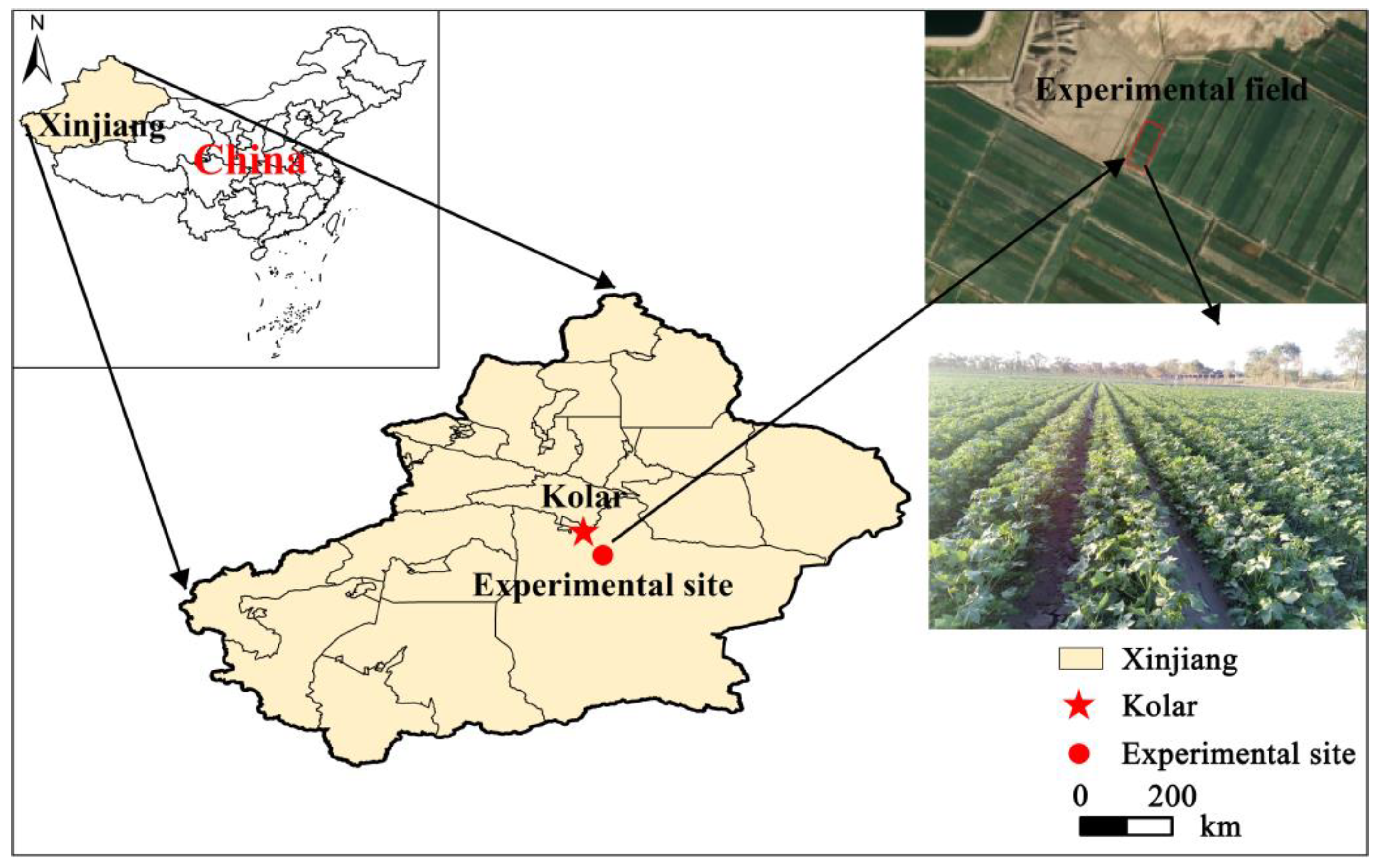
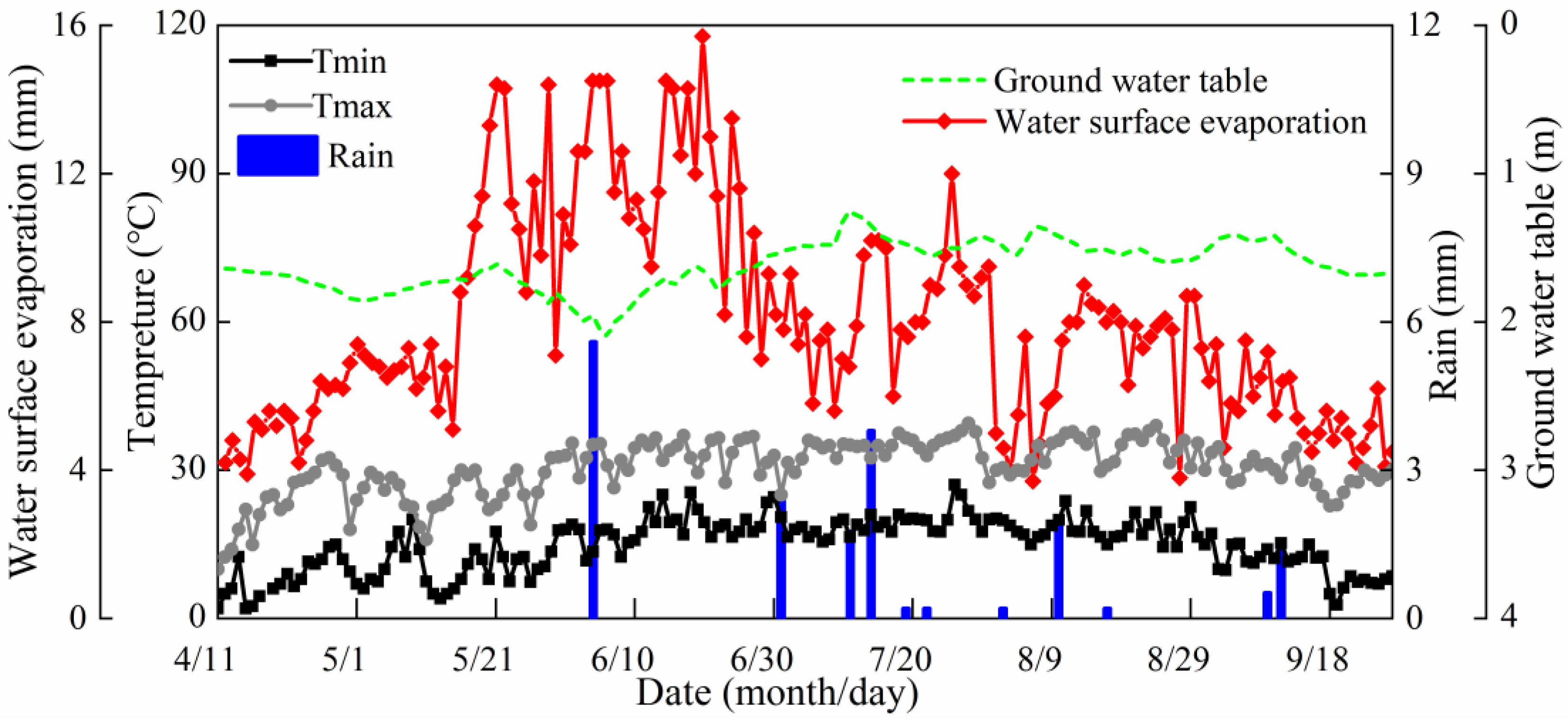

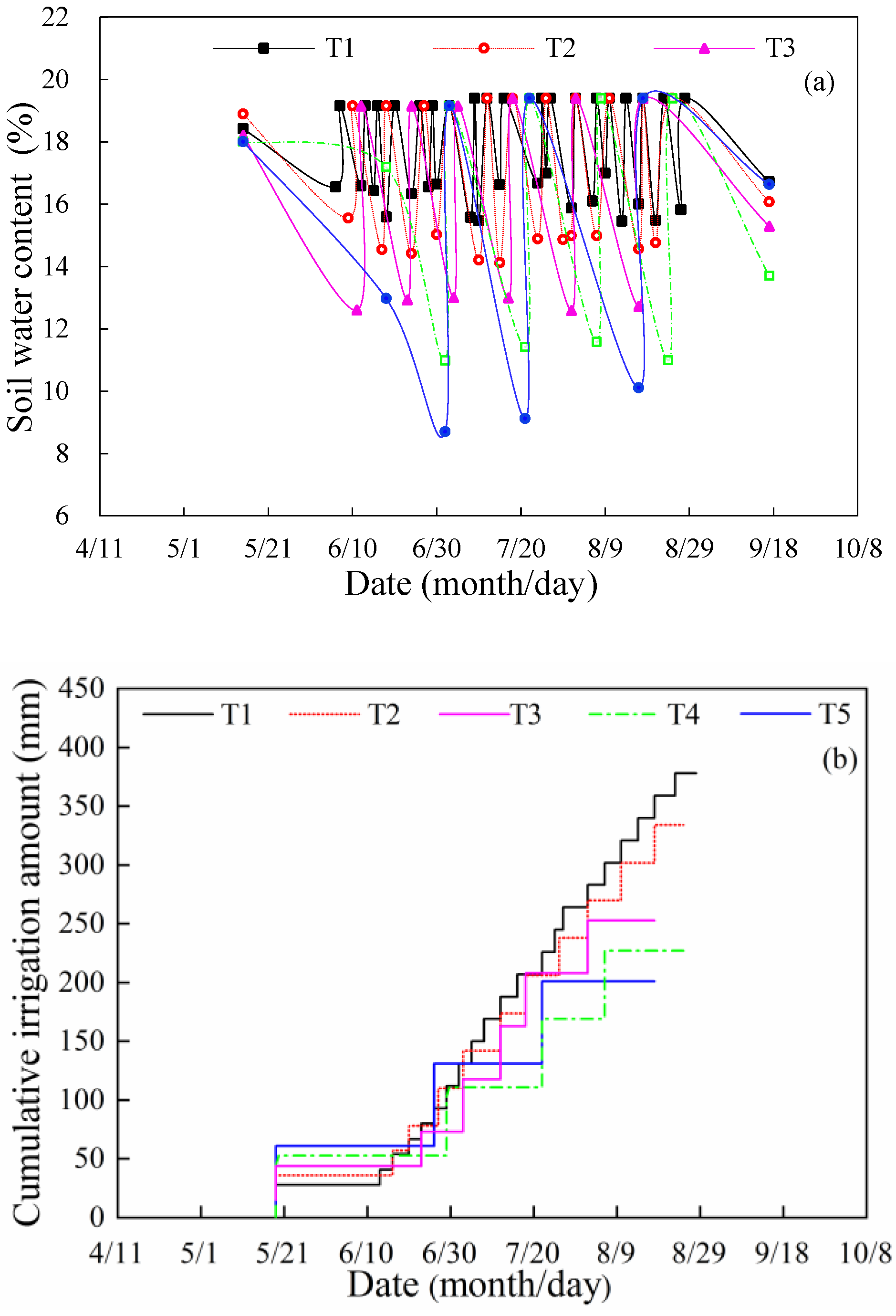
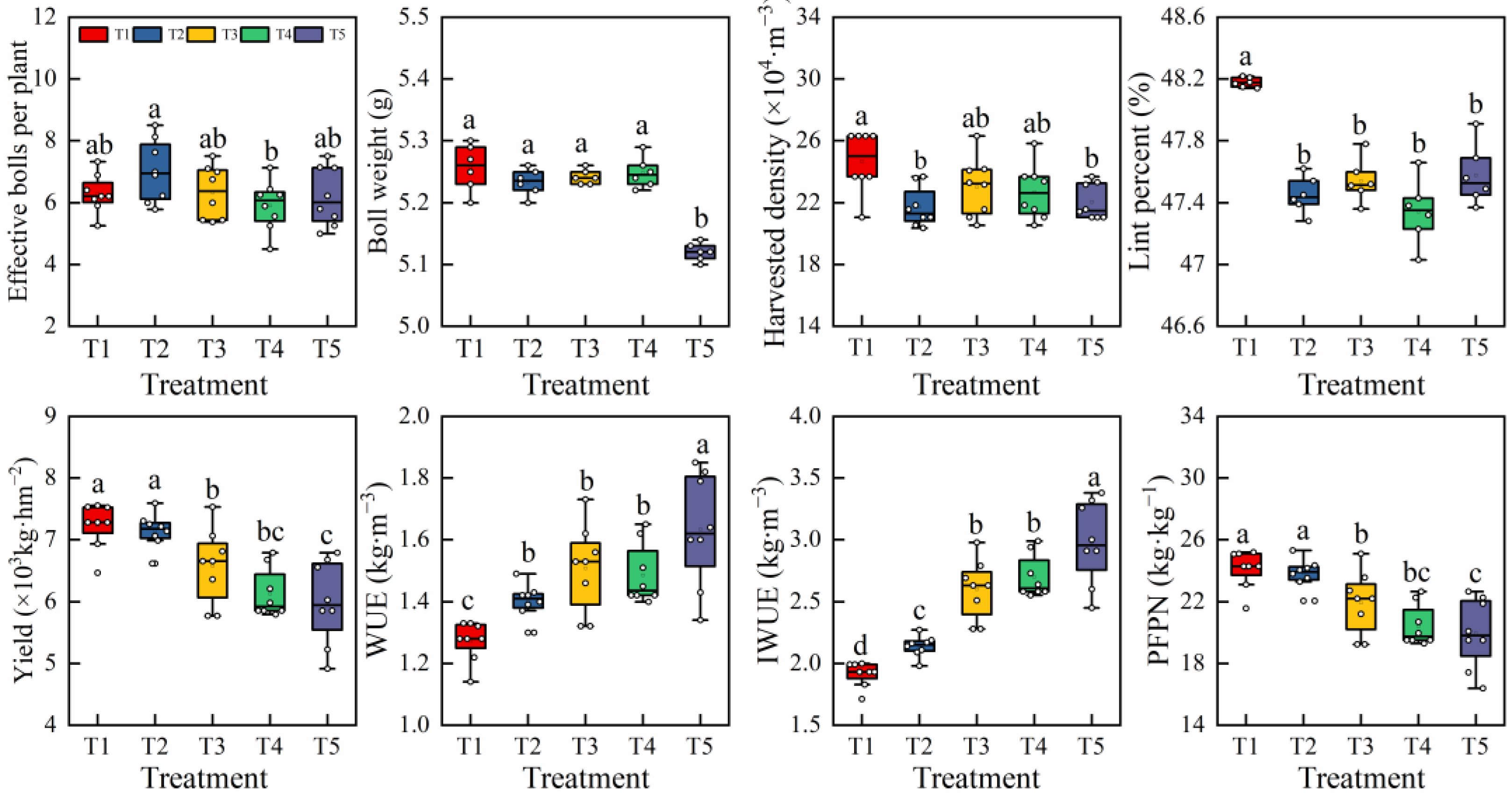
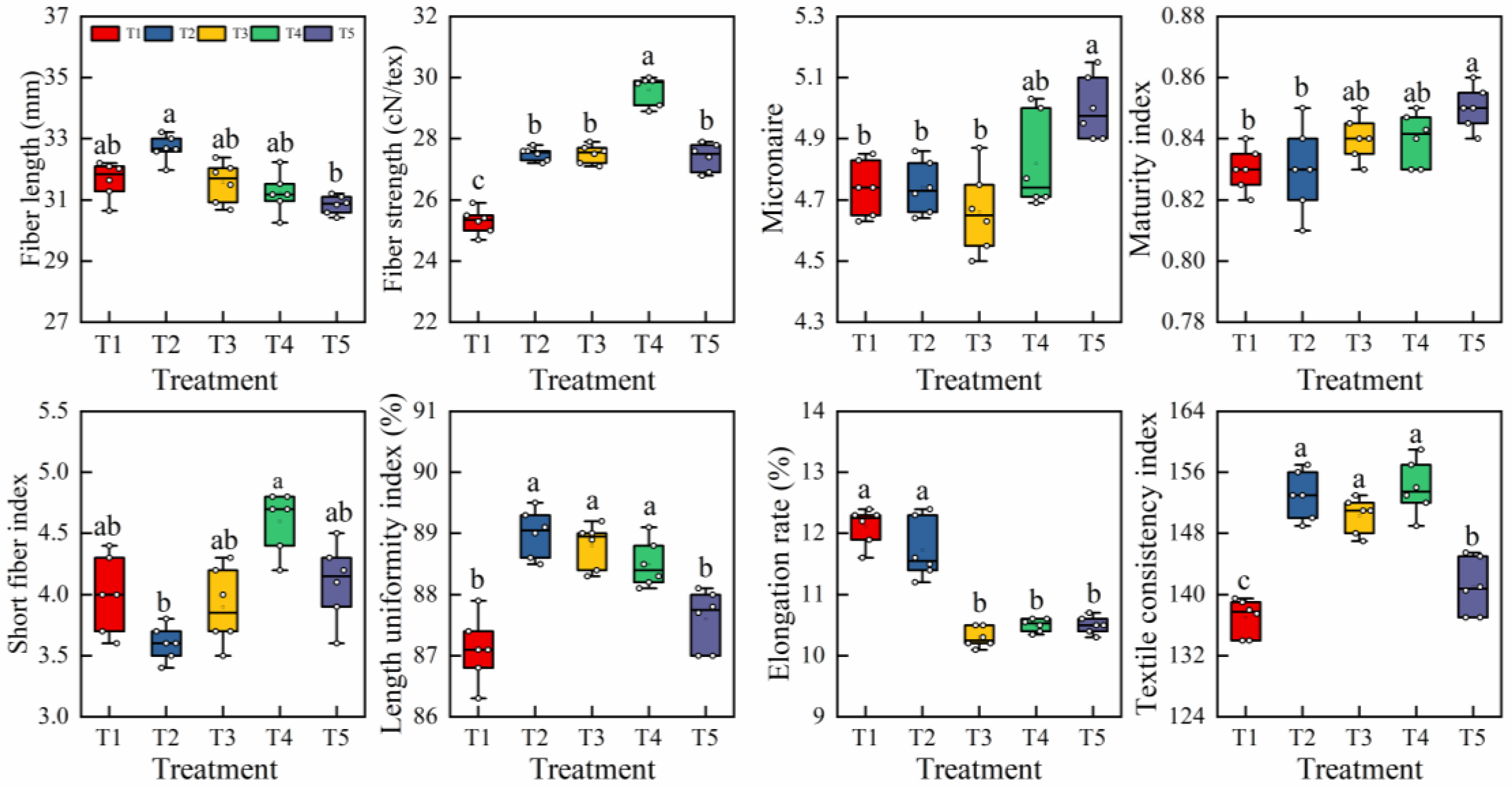
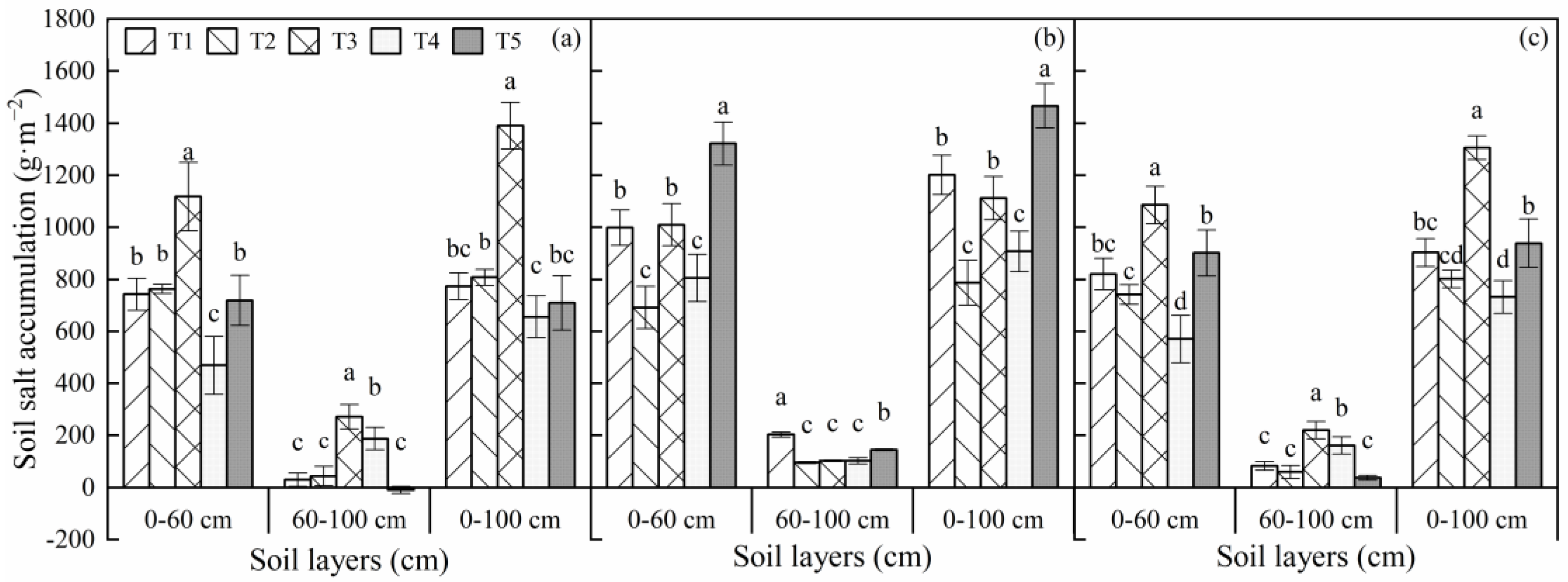
| Depth (cm) | Soil Texture | Soil Mechanical Composition (%) | Bulk Density (g∙cm−3) | Field Water Capacity (%) | Soil Moisture Content (%) | Soil Salinity (g∙kg−1) | NO3-N (mg∙kg−1) | NH4-N (mg∙kg−1) | ||
|---|---|---|---|---|---|---|---|---|---|---|
| Clay | Silt | Sand | ||||||||
| 0~10 | Sandy loam | 2.00 | 43.54 | 54.46 | 1.59 | 32.87 | 15.21 | 0.46 | 16.69 | 9.58 |
| 10~20 | Silt loam | 3.30 | 49.30 | 47.41 | 1.44 | 32.86 | 15.02 | 0.43 | 15.58 | 9.44 |
| 20~40 | Silt loam | 2.83 | 51.13 | 46.05 | 1.63 | 27.35 | 19.91 | 0.46 | 15.58 | 9.39 |
| 40~60 | Sandy loam | 3.12 | 44.79 | 52.09 | 1.57 | 31.23 | 24.70 | 0.53 | 11.13 | 7.03 |
| 60~80 | Sandy | 0.00 | 10.16 | 89.84 | 1.70 | 20.74 | 20.46 | 0.63 | 12.31 | 6.99 |
| 80~100 | Sandy | 0.00 | 6.80 | 93.20 | 1.66 | 20.54 | 19.48 | 0.63 | 12.15 | 6.54 |
| Treatment | Seedling~Budding (4/11~6/19) | Budding~Flowering (6/20~7/26) | Boll Forming (7/27~8/22) | Boll Bearing (8/23~9/17) | ||||
|---|---|---|---|---|---|---|---|---|
| Intensity (mm∙d−1) | Modulus (%) | Intensity (mm∙d−1) | Modulus (%) | Intensity (mm∙d−1) | Modulus (%) | Intensity (mm∙d−1) | Modulus (%) | |
| T1 | 2.08 | 25.31 | 5.78 | 37.65 | 5.41 | 25.74 | 2.47 | 11.30 |
| T2 | 1.46 | 19.80 | 5.47 | 39.77 | 5.63 | 29.89 | 2.06 | 10.54 |
| T3 | 0.99 | 15.72 | 5.84 | 49.56 | 3.11 | 19.26 | 2.59 | 15.45 |
| T4 | 1.24 | 20.81 | 2.95 | 26.51 | 4.56 | 29.88 | 3.61 | 22.79 |
| T5 | 1.55 | 29.14 | 3.79 | 38.27 | 2.47 | 18.17 | 2.03 | 14.42 |
| Treatment | Soil Layers Inside the Film (cm) | Soil Layers Outside the Film (cm) | Soil Layers (cm) | ||||||
|---|---|---|---|---|---|---|---|---|---|
| 0~60 | 60~100 | 0~100 | 0~60 | 60~100 | 0~100 | 0~60 | 60~100 | 0~100 | |
| T1 | 154.77 b | 6.89 c | 87.44 bc | 174.57 b | 46.17 a | 121.55 b | 161.51 bc | 18.85 c | 98.54 b |
| T2 | 157.66 b | 10.38 c | 90.56 b | 119.27 c | 21.83 c | 79.03 c | 144.47 c | 13.81 c | 86.77 c |
| T3 | 230.36 a | 61.98 a | 153.87 a | 172.69 b | 23.39 c | 111.04 b | 210.49 a | 50.22 a | 139.84 a |
| T4 | 96.64 c | 42.95 b | 71.94 c | 138.20 c | 23.20 c | 90.71 c | 110.77 d | 36.86 b | 78.03 c |
| T5 | 149.51 b | −2.51 c | 80.28 bc | 226.46 a | 32.80 b | 146.49 a | 175.81 b | 8.29 c | 101.86 b |
| First-Class Index Layer | Second-Class Index Layer | Index Number | Index Type | Treatment | ||||
|---|---|---|---|---|---|---|---|---|
| T1 | T2 | T3 | T4 | T5 | ||||
| Yield Index | Yield (kg∙hm−2) | 1 | Positive | 7233.2 a | 7146.5 a | 6577.6 b | 6127.4 bc | 5988.4 c |
| Water and nitrogen index | WUE (kg∙m−3) | 2 | Positive | 1.29 c | 1.43 b | 1.54 b | 1.52 b | 1.67 a |
| PFPN (kg∙kg−1) | 3 | Positive | 24.11 a | 23.82 a | 21.93 b | 20.43 bc | 19.96 c | |
| Salt index | Salt accumulation (g∙m−2) | 4 | Reverse | 902.8 b | 801.53 c | 1306.1 a | 732.25 c | 938.54 b |
| Quality index | Fiber length (mm) | 5 | Positive | 31.65 ab | 32.69 a | 31.07 ab | 31.22 ab | 30.84 b |
| Length uniformity index (%) | 6 | Positive | 87.1 b | 89 a | 88.8 a | 88.5 a | 87.6 b | |
| Breaking strength (cN/tex) | 7 | Positive | 25.3 c | 27.5 b | 27.5 b | 29.6 a | 27.4 b | |
| Elongation rate (%) | 8 | Reverse | 12.1 a | 11.6 a | 10.3 b | 10.5 b | 10.5 b | |
| Micronaire | 9 | Reverse | 4.74 b | 4.74 b | 4.65 b | 4.81 ab | 5 a | |
| Short fiber index (%) | 10 | Reverse | 4 ab | 3.6 b | 3.9 ab | 4.6 a | 4.1 ab | |
| Maturity index | 11 | Reverse | 0.83 b | 0.83 b | 0.84 ab | 0.84 ab | 0.85 a | |
| Textile consistency index | 12 | Positive | 137 c | 153 a | 150 a | 154 a | 141 b | |
| Economic index | Economic benefit (CNY∙hm−2) | 13 | Positive | 27,242 a | 26,856 a | 23,278 b | 20,257 c | 19,416 c |
| Treatment | T1 | T2 | T3 | T4 | T5 |
|---|---|---|---|---|---|
| Positive ideal solution distance D+ | 0.17 | 0.08 | 0.16 | 0.20 | 0.24 |
| Negative ideal solution distance D− | 0.20 | 0.25 | 0.17 | 0.16 | 0.11 |
| Relative proximity C | 0.54 | 0.77 | 0.52 | 0.45 | 0.31 |
| Rank | 2 | 1 | 3 | 4 | 5 |
Publisher’s Note: MDPI stays neutral with regard to jurisdictional claims in published maps and institutional affiliations. |
© 2022 by the authors. Licensee MDPI, Basel, Switzerland. This article is an open access article distributed under the terms and conditions of the Creative Commons Attribution (CC BY) license (https://creativecommons.org/licenses/by/4.0/).
Share and Cite
He, P.; Yu, S.; Zhang, F.; Ma, T.; Ding, J.; Chen, K.; Chen, X.; Dai, Y. Effects of Soil Water Regulation on the Cotton Yield, Fiber Quality and Soil Salt Accumulation under Mulched Drip Irrigation in Southern Xinjiang, China. Agronomy 2022, 12, 1246. https://doi.org/10.3390/agronomy12051246
He P, Yu S, Zhang F, Ma T, Ding J, Chen K, Chen X, Dai Y. Effects of Soil Water Regulation on the Cotton Yield, Fiber Quality and Soil Salt Accumulation under Mulched Drip Irrigation in Southern Xinjiang, China. Agronomy. 2022; 12(5):1246. https://doi.org/10.3390/agronomy12051246
Chicago/Turabian StyleHe, Pingru, Shuang’en Yu, Fucang Zhang, Tao Ma, Jihui Ding, Kaiwen Chen, Xin Chen, and Yan Dai. 2022. "Effects of Soil Water Regulation on the Cotton Yield, Fiber Quality and Soil Salt Accumulation under Mulched Drip Irrigation in Southern Xinjiang, China" Agronomy 12, no. 5: 1246. https://doi.org/10.3390/agronomy12051246
APA StyleHe, P., Yu, S., Zhang, F., Ma, T., Ding, J., Chen, K., Chen, X., & Dai, Y. (2022). Effects of Soil Water Regulation on the Cotton Yield, Fiber Quality and Soil Salt Accumulation under Mulched Drip Irrigation in Southern Xinjiang, China. Agronomy, 12(5), 1246. https://doi.org/10.3390/agronomy12051246







